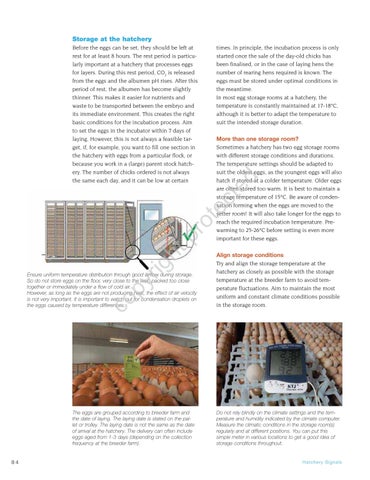Storage at the hatchery times. In principle, the incubation process is only started once the sale of the day-old chicks has been finalised, or in the case of laying hens the number of rearing hens required is known. The eggs must be stored under optimal conditions in the meantime. In most egg storage rooms at a hatchery, the temperature is constantly maintained at 17-18°C, although it is better to adapt the temperature to suit the intended storage duration.
d
More than one storage room? Sometimes a hatchery has two egg storage rooms with different storage conditions and durations. The temperature settings should be adapted to suit the oldest eggs, as the youngest eggs will also hatch if stored at a colder temperature. Older eggs are often stored too warm. It is best to maintain a storage temperature of 15°C. Be aware of condensation forming when the eggs are moved to the setter room! It will also take longer for the eggs to reach the required incubation temperature. Prewarming to 25-26°C before setting is even more important for these eggs.
rig
ht
pr ot
ec
te
Before the eggs can be set, they should be left at rest for at least 8 hours. The rest period is particularly important at a hatchery that processes eggs for layers. During this rest period, CO2 is released from the eggs and the albumen pH rises. After this period of rest, the albumen has become slightly thinner. This makes it easier for nutrients and waste to be transported between the embryo and its immediate environment. This creates the right basic conditions for the incubation process. Aim to set the eggs in the incubator within 7 days of laying. However, this is not always a feasible target, if, for example, you want to fill one section in the hatchery with eggs from a particular flock, or because you work in a (large) parent stock hatchery. The number of chicks ordered is not always the same each day, and it can be low at certain
co
py
Ensure uniform temperature distribution through good airflow during storage. So do not store eggs on the floor, very close to the wall, packed too close together or immediately under a flow of cold air. However, as long as the eggs are not producing heat, the effect of air velocity is not very important. It is important to watch out for condensation droplets on the eggs caused by temperature differences.
The eggs are grouped according to breeder farm and the date of laying. The laying date is stated on the pallet or trolley. The laying date is not the same as the date of arrival at the hatchery. The delivery can often include eggs aged from 1-3 days (depending on the collection frequency at the breeder farm).
84
Align storage conditions Try and align the storage temperature at the hatchery as closely as possible with the storage temperature at the breeder farm to avoid temperature fluctuations. Aim to maintain the most uniform and constant climate conditions possible in the storage room.
Do not rely blindly on the climate settings and the temperature and humidity indicated by the climate computer. Measure the climatic conditions in the storage room(s) regularly and at different positions. You can put this simple meter in various locations to get a good idea of storage conditions throughout.
Ha tc he ry S i gnal s
